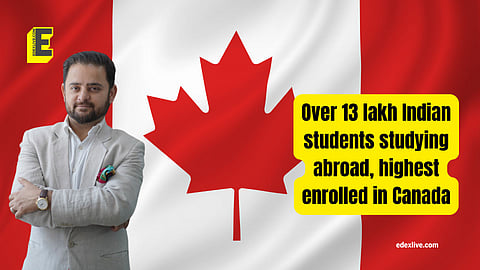Out of 13 lakh Indian students studying abroad, highest are studying in Canada. How did that happen?
Despite diplomatic situation, highest Indian students studying abroad are from Canada. How so?
Yes, it's true that Canada attracts a large number of Indian students, almost at par with the number heading to the United States (US), despite having far fewer universities and institutions. There are many reasons for this surge in numbers.
Firstly, Canadian tuition fees is much lower compared to the US, the United Kingdom (UK), or even some parts of Europe, making it a more affordable option for students.
Secondly, Canada pre and post-COVID has been very welcoming to foreigners, especially Indians, which makes it easier for Indian students to obtain visas compared to some other countries.
Lastly, the Indian diaspora in Canada is one of the largest. Many Indian students have family or friends already living there, which provides immediate local support upon arrival. This extensive network also means they can gather a lot of useful information before making the move, which might not be as accessible for other countries without such networks.
These factors make Canada a highly attractive destination for Indian students seeking quality education abroad.
There was also talk of rampant unemployment in Canada for Indian students. How true is this?
Yes, there has been a slight uptick in the unemployment rate, rising from 6.2% to about 6.4% last month. This increase is primarily due to rising inflation rates, which led Canadian banks to implement some rate cuts.
While permanent jobs have become somewhat scarce, part-time jobs have seen an increase. Many companies are hesitant to commit to full-time positions, making part-time work more available for students who have recently graduated.
Additionally, there was some confusion in the past few months regarding the Post-Graduate Work Permit (PWB).
At one point, it was completely withdrawn, causing uncertainty in the job market. However, it has since been reinstated, allowing students to stay in Canada for three years after completing their postgraduate studies. This reinstatement should help stabilise the job market for students.
Overall, while the current job market presents some challenges, these issues are likely temporary. We expect it to bounce back in the near future.
Will the recent policy changes, capped study permits, and so on have an impact on the upcoming batches?
Acclaimed for its esteemed universities, Canada’s strategic stance on putting a cap may impact outbound Indian students in the short to medium term, but in the long run, it promises a fair opportunity for those genuinely seeking quality education.
This adjustment will also foster growth in the student accommodation industry, offering quality living options and mitigating cost-of-living inflation. This will also seek to address economic stabilisation within the country.
With anticipated job opportunities and eligibility for a three-year work permit for graduates, this transformative shift holds positive prospects for students and the broader community.
Traditionally what makes Canada so lucrative.
Despite Canada's policy changes, the fundamental qualities that make the country attractive to international students remain unchanged. Canada’s welcoming atmosphere and top-notch public universities continue to be major draws.
Most importantly, Canada still offers better chances of settling down post-studies compared to other countries. Students can obtain a work permit after completing their education and subsequently apply for Permanent Residency (PR).



